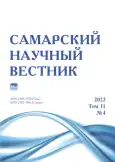The ecological and epidemiological situation of tick-borne encephalitis and Lyme borreliosis in the Republic of Tatarstan for the period of 2017–2021
- Authors: Gubeidullina A.K.1
-
Affiliations:
- Kazan (Volga Region) Federal University
- Issue: Vol 11, No 4 (2022)
- Pages: 18-21
- Section: Biological Sciences
- URL: https://journals.rcsi.science/2309-4370/article/view/133213
- DOI: https://doi.org/10.55355/snv2022114102
- ID: 133213
Cite item
Full Text
Abstract
Of the huge order of parasitoform mites in the circulatory chain of the occurrence of existing pathogens and new pathogens of infections joining them, a significant role belongs to ixodic mites (I. persulcatus Sch., I. ricinus Lin.). These blood-sucking parasites are the main carriers of more than 10 nosological forms of zoonotic infections identified in the Republic of Tatarstan. Of these, a special place in the regional pathology is occupied by Lyme borreliosis and tick-borne encephalitis. Despite the relative duration of monitoring of natural focal infections in Tatarstan, the problem of this group of diseases has not disappeared and requires close attention and analysis of the current epidemiological and epizootological state. Based on our own research and stock materials of sanitary and epidemiological services, the ranking of enzootic territories representing a certain degree of risk of infection of the population in the Republic of Tatarstan by tick-borne encephalitis and Lyme borreliosis in the context of administrative territories was carried out. In the region, for the period of 2017–2021, there was a decrease in the intensity of infection of the tick-borne encephalitis population (5 cases in 5 years). At the same time, a high degree of risk of infection of the population with Lyme borreliosis was revealed.
Full Text
##article.viewOnOriginalSite##About the authors
Alsou Kharisovna Gubeidullina
Kazan (Volga Region) Federal University
Author for correspondence.
Email: alsu.har108@gmail.com
candidate of biological sciences, associate professor of Zoology and General Biology Department
Russian Federation, KazanReferences
- Бойко В.А., Трифонов В.А., Решетникова И.Д., Агафонова Е.В., Исаева Г.Ш., Савицкая Т.А., Губейдуллина А.Х. Паразитарные комплексы, эпизоотическая активность, эпидемиологическое проявление природных очагов доминирующих зоонозов в формате ландшафтных подзон республики Татарстан (региональный, экологический мониторинг, 1955–2015 гг.) / отв. ред. В.Б. Зиатдинов. Казань, 2021. 83 с.
- Бойко В.А. Лесные виды иксодовых клешей (Ixodidae): их экология, медицинское значение в условиях антропогенной трансформации ландшафтов Среднего Поволжья и регионального изменения климата / отв. ред. Р.С. Фассахов. Казань: Медицина, 2014. 75 с.
- Шамсутдинов А.Ф., Бойко В.А., Трифонов В.А., Фассахов Р.С., Решетникова И.Д., Крючков Р.А., Агафонова Е.В. Анализ эпидемиологической обстановки по природно-очаговым зооантропонозам в краевой инфекционной патологии Республики Татарстан. Иксодовый клещевой боррелиоз, эрлихиоз и анаплазмоз // Практическая медицина. 2015. № 7 (92). С. 120–123.
- О состоянии санитарно-эпидемиологического благополучия населения в Республике Татарстан в 2017 году: государственный доклад / под общ. ред. М.А. Патяшиной. Казань, 2017. 292 с.
- О состоянии санитарно-эпидемиологического благополучия населения в Республике Татарстан в 2018 году: государственный доклад / под общ. ред. М.А. Патяшиной. Казань, 2018. 361 с.
- О состоянии санитарно-эпидемиологического благополучия населения в Республике Татарстан в 2019 году: государственный доклад / под общ. ред. М.А. Патяшиной. Казань, 2019. 356 с.
- О состоянии санитарно-эпидемиологического благополучия населения в Республике Татарстан в 2020 году: государственный доклад / под общ. ред. М.А. Патяшиной. Казань, 2020. 366 с.
- О состоянии санитарно-эпидемиологического благополучия населения в Республике Татарстан в 2021 году: государственный доклад / под общ. ред. М.А. Патяшиной. Казань, 2021. 359 с.
- Коренберг Э.И., Посмелова В.Г., Осин Н.С. Природноочаговые инфекции, передающиеся иксодовыми клещами: учеб. пособие / под ред. А.Л. Гинцбурга, В.Н. Злобина. М.: Наука, 2013. 462 с.
Supplementary files







